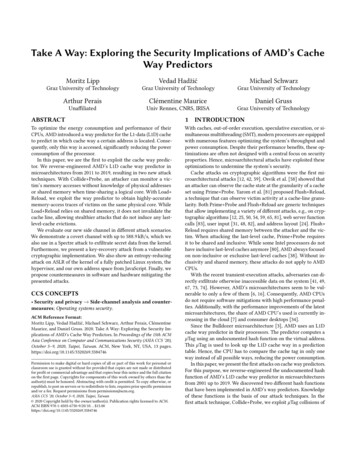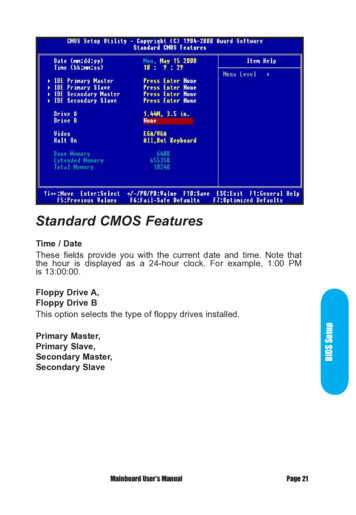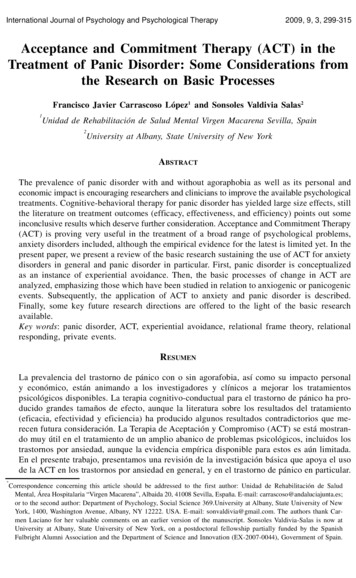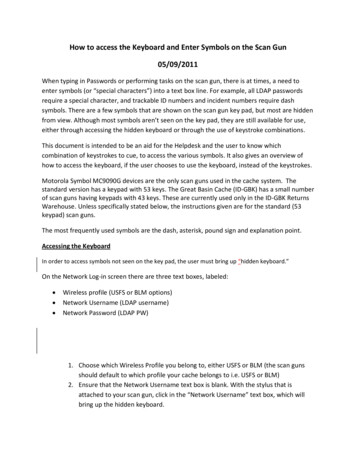
Transcription
Cache Games – Bringing Access-Based Cache Attacks on AES to PracticeEndre BangerterBern University of Applied Sciencesendre.bangerter@bfh.chDavid GullaschBern University of Applied Sciences,Dreamlab Technologiesdavid.gullasch@bfh.chAbstract—Side channel attacks on cryptographic systems areattacks exploiting information gained from physical implementations rather than utilizing theoretical weaknesses of a scheme.In particular, during the last years, major achievements weremade for the class of access-driven cache-attacks. The sourceof information leakage for such attacks are the locations ofmemory accesses performed by a victim process.In this paper we analyze the case of AES and present an attack which is capable of recovering the full secret key in almostrealtime for AES-128, requiring only a very limited number ofobserved encryptions. Unlike most other attacks, ours neitherneeds to know the ciphertext, nor does it need to know anyinformation about the plaintext (such as its distribution, etc.).Moreover, for the first time we also show how the plaintextcan be recovered without having access to the ciphertext.Further, our spy process can be run under an unprivilegeduser account. It is the first working attack for implementationsusing compressed tables, where it is not possible to find outthe beginning of AES rounds any more – a corner stone for allefficient previous attacks. All results of our attack have beendemonstrated by a fully working implementation, and do notsolely rely on theoretical considerations or simulations.A contribution of probably independent interest is a denialof service attack on the scheduler of current Linux systems(CFS), which allows to monitor memory accesses with novellyhigh precision. Finally, we give some generalizations of ourattack, and suggest some possible countermeasures whichwould render our attack impossible.Keywords-AES; side channel; access-based cache-attacks;I. I NTRODUCTIONCryptographic schemes preventing confidential data frombeing accessed by unauthorized users have become increasingly important during the last decades. Before beingdeployed in practice, such schemes typically have to passa rigorous reviewing process to avoid design weaknessesand bugs. However, theoretical soundness of a schemeis not necessarily sufficient for the security of concreteimplementations of the scheme.Side-channel attacks are an important class of implementation level attacks on cryptographic systems. They exploit,for instance, the leakage of information from electromagnetic radiation or power consumption of a device, andrunning times of certain operations. Especially, side-channelThis work was in part funded by the European Community’s SeventhFramework Programme (FP7) under grant agreement no. 216499.Stephan KrennBern University of Applied Sciences,University of Fribourgstephan.krenn@bfh.chattacks based on cache access mechanisms of microprocessors represented a vivid area of research in the last few years,e.g., [1]–[15]. These cache based side-channel attacks (orcache attacks for short) split into three types: time-driven,trace-driven, and access-driven attacks.In time-driven attacks an adversary is able to observe theoverall time needed to perform certain computations, such aswhole encryptions [8]–[11]. From these timings he can makeinferences about the overall number of cache hits and missesduring an encryption. On the other hand, in trace-drivenattacks, an adversary is able to obtain a profile of the cacheactivity during an encryption, and to deduce which memoryaccesses issued by the cipher resulted in a cache hit [12]–[15]. Finally, access-driven attacks additionally enable theadversary to determine the cache sets accessed by thecipher [4]–[6]. Therefore, he can infere which elements of,e.g., a lookup table have been accessed by the cipher.Using the fact that accessing data which has already beencopied into the cache is up to two orders of magnitudefaster than accessing data in the main memory, access-drivenattacks roughly work as follows: assume two concurrentlyrunning processes (a spy process S and a cryptographicvictim process V ) using the same cache. After letting Vrun for some small amount of time and potentially lettingit change the state of the cache, S observes the timingsof its own memory accesses, which depend on the state ofthe cache. These measurements allow S to infer informationabout the memory locations previously accessed by V .A. Our ContributionsIn a nutshell, we present a novel, practically efficientaccess-driven cache attack on the Advanced EncryptionStandard (AES) [16], [17], one of the most popularsymmetric-key block-ciphers. On a high-level the main properties of our attack are two-fold: first, our attack works undervery weak assumptions, and is thus the strongest workingaccess-driven attack currently known. Second, we provide aconcrete and practically usable implementation of the attack,based on new techniques. We also resolve a series of so faropen issues and technicalities.Let us describe these properties and the underlying technical contributions in more detail. In fact, for our attackto work we only need to assume that the attacker has a test
machine at his disposal prior to the attack, which is identicalto the victim machine. The test machine is used to carry outan offline learning phase which consists of about 1680 000encryptions. Further, two artificial neural network have tobe trained on an arbitrary platform.To carry out the attack all we need to be able to is toexecute a non-privileged spy process (e.g., our spy processdoes not need to have access to the network interface) on thevictim machine. We don’t require any explicit interactions,such as interprocess communication or I/O. Osvik et al. [6],[7] refer to attacks in this setting as asynchronous attacks.Our attack technique has the following features: In contrast to previous work [5]–[7], our spy processneither needs to learn the plain- or ciphertexts involved,nor their probability distributions in order recover thesecret key.For the first time, we describe how besides the keyalso the plaintext can be recovered without knowingthe ciphertexts at all.Our attack also works against AES implementationsusing so called compressed tables, which are typicallyused in practice, e.g., in OpenSSL [18]. When usingcompressed tables, the first, respectively last round ofan encryption typically cannot be identified any more,which renders previous attacks impossible.We have a fully working implementation of our attacktechniques against the 128-bit AES implementation ofOpenSSL 0.9.8n on Linux. It is highly efficient andis able to recover keys in “realtime”. More precisely,it consists of two phases: in an oberservation phase,which lasts about 2.8 seconds on our test machine,about 100 encryptions have to be monitored. Then, anoffline analysis phase, lasting about 3 minutes recoversthe key. The victim machine only experiences a delayduring the observation phase. This slowdown is sufficiently slight to not raise suspicions, since it might aswell be caused by high network traffic, disk activity,etc. To the best of our knowledge, this is the first fullyfunctional implementation in the asynchronous setting.At the heart of the attack is a spy process which is ableto observe (on average) every single memory accessof the victim process. This novelly high granularity inthe observation of cache hits and misses is reached bya new technique exploiting the behavior of the Completely Fair Scheduler (CFS) used by modern Linuxkernels. We believe that this scheduler attack could beof independent interest.Finally, we also describe a novel approach to reconstruct the AES key from the leaked key bits leaked.To emphasize the practicability of our attack, let ussketch how it could be used to mount a targeted malwareattack (which are currently regularly seen in practice). Ina targeted attack we may assume that the attacker knowsthe configuration of the victim machine and can thus obtainan identical machine, which is one of our preconditions.Next, standard malware infection techniques can be usedto compromise a non-privileged account and to deploy ourcustom payload on the victim machine. Since we only needto observe around 100 encryptions, which correspond to 1.56kilobytes of ciphertext, we are able to recover the secretkey almost immediately whenever AES is being used on thevictim machine after a successful infection.B. Related WorkIt was first mentioned in [19], [20] that the cache behaviorpotentially poses a security threat. The first formal studiesof such attacks were given by Page [21], [22].First practical results for time-driven cache attacks onthe Data Encryption Standard (DES) were given in [2],and an adoption for AES was mentioned without givingdetails. Differently efficient time-driven attacks on AES canbe found in [6]–[11], some of which require that the firstrespectively last round of AES can be identified. In [23], ananalytical model for forecasting the security of symmetricciphers against such attacks is proposed.Trace-driven cache attacks were first described in [21].Other such attacks on AES can be found, e.g., in [12]–[15]. Especially, [12] proposes a model for analyzing theefficiency of trace-driven attacks against symmetric ciphers.Percival [4] pioneered the work on access-driven attacksand described an attack on RSA. Access-driven attacks onAES were pioneered by Osvik et al. [6], [7]. They describevarious attack techniques and implementations in what theycall the synchronous model. The synchronous model makesrather strong assumptions on the capabilities on an attacker,i.e., it assumes that an attacker has the ability to triggeran encryption for known plaintexts and know when anencryption has begun and ended. Their best attack in thesynchronous model requires about 300 encryptions.Osvik et al. also explore the feasibility of asynchronousattacks. They refer to asynchronous attacks as an “extremelystrong type of attack”, and describe on a rather high-levelhow such attacks could be carried out, assuming that theattacker knows the plaintext distribution and that the attack iscarried out on a multi-threaded CPU. Also, they implementand perform some measurements on multi-threaded CPUswhich allow to recover 47 key-bits. However, a description(let alone an implementation) of a full attack is not given,and many open questions are left unresolved. Further, theauthors conjecture that once fine grained observations ofcache-accesses are possible, the plaintext distribution nolonger needs to be known. Loosely speaking, one cansay that Osvik et al. postulate fully worked and practicalasynchronous attacks as an open problem.This is where the work of Neve et al. [5] picks up. Theymake advances towards realizing asynchronous attacks. Tothis end they describe and implement a spy process that
is able to observe a “few cache accesses per encryption”and which works on single threaded CPUs. They thendescribe a theoretical known ciphertext attack to recoverkeys by analyzing the last round of AES. The practicalityof their attack remains unclear, since they do not provide animplementation and leave various conceptual issues (e.g.,quality of noise reduction, etc.) open.We improve over prior work by providing a first practicalaccess-driven cache attack on AES in the asynchronousmodel. The attack works under weaker assumptions thanprevious ones, as no information about plain- and ciphertextis required1 , and it is more efficient in the sense that weonly need to observe about 100 encryptions. We also reach anovelly high granularity when monitoring memory-accesses.Further, our attack also works against compressed tables,which were not considered before.Finally, several hardware and software based mitigationsstrategies for AES have been proposed, e.g., [24]–[26].C. Organization of this DocumentIn §II we briefly recapitulate the structure of a CPU cache,and the logics underlying it. We also describe the AdvancedEncryption Standard (AES) to the extent necessary for ourattack. In §III we then explain how to recover the AESkey under the assumption that one was able to perfectlyobserve the single cache-accesses performed by the victimprocess. We drop this idealization in §IV and show how bycombining a novel attack on the task scheduler and neuralnetworks sufficiently good measurements can be obtained inpractice. We give some real measurements and extensionsof our attack in §V. In particular, we there sketch how toobtain the plaintext without knowing the ciphertext. Finally,we propose some countermeasures in §VI.II. P RELIMINARIESWe first summarize the functioning of the CPU cacheas far as necessary for understanding our attack. We thendescribe AES, and give some details on how it is typicallyimplemented. We close this section by describing the testenvironment on which we obtained our measurements.A. The CPU Cache and its Side ChannelsWe next describe the behavior of the CPU cache, andhow it can be exploited as a side channel. The CPU cacheis a very fast memory which is placed between the mainmemory and the CPU [27]. Its size typically ranges fromsome hundred kilobytes up to a few megabytes.Typically, data the CPU attempts to access is first loadedinto the cache, provided that it is not already there. Thislatter case is called a cache hit, and the requested data1 To be precise, the statement is true whenever AES is used, e.g., in CBCor CTR mode, which is the case for (all) relevant protocols and applications.In the pathological and practically irrelevant case, where the ECB mode(which is known to be insecure by design) is used we have to require thatthere is some randomness in the plaintext.can be supplied to the CPU core with almost no latency.However, if a cache miss occurs, the data first has to befetched via the front side bus and copied into the cache, withthe resulting latency being roughly two orders of magnitudehigher than in the former case. Consequently, although beinglogically transparent, the mechanics of the CPU cache leakinformation about memory accesses to an adversary who iscapable of monitoring cache hits and misses.To understand this problem in more detail it is necessaryto know the functioning of an n-way associative cache,where each address in the main memory can be mapped intoexactly n different positions in the cache. The cache consistsof 2a cache-sets of n cache-lines each. A cache-line is thesmallest amount of data the cache can work with, and itholds 2b bytes of data, which are accompanied by tag andstate bits. Cache line sizes of 64 or 128 bytes (correspondingto b 6 and b 7, respectively) are prevalent on modernx86- and x64-architectures.To locate the cache-line holding data from address A (Amax , . . . , A0 ), the b least significant bits of A can beignored, as a cache-line always holds 2b bytes. The nexta bits, i.e., (Aa b 1 , . . . , Ab ) identify the cache-set. Theremaining bits, i.e., (Amax , . . . , Aa b ) serve as a tag. Now,when requesting data from some address A, the cache logiccompares the tag corresponding to A with all tags of the(unique) possible cache-set, to either successfully find thesought cache-line or to signal a cache miss. The state bitsindicate if the data is, e.g., valid, shared or modified (theexact semantics are implementation defined). We typicallyhave max 31 on x86-architectures and max 63 onx64-architectures (however, the usage of physical addressextension techniques may increase the value of max [28]).Addresses mapping into the same cache-set are said toalias in the cache. When more then n memory accesses todifferent aliasing addresses have occurred, the cache logicneeds to evict cache-lines (i.e. modified data needs to bewritten back to RAM and the cacheline is reused). Thisis done according to a predetermined replacement strategy,most often an undocumented algorithm (e.g. PseudoLRU inx86 CPUs), approximating the eviction of the least recentlyused (LRU) entry.With these mechanics in mind, one can see that thereare at least two situations where information can leak toan adversary in multi-tasking operating systems (OS). Let’stherefore assume that a victim process V , and a spy processS are executed concurrently, and that the cache has beeninitialized by S. After running V for some (small) amountof time, the OS switches back to S. If S and V physically share main memory (i.e., theirvirtual memories map into the same memory pages inRAM), S starts by flushing the whole cache. Afterregaining control over the CPU, S reads from memory locations and monitors cache hits and misses byobserving the latency.
If S and V do not physically share memory, thenthey typically have access to cache aliasing memory.In this case, S initializes the cache with some data D,and using its knowledge of the replacement strategy,it deterministically prepares the individual cache-linestates. When being scheduled again, S again accessesD, and notes which data had been evicted from thecache. This again allows S to infer information aboutthe memory accesses of V .Our target is the OpenSSL library on Linux, which inpractice resides at only one place in physical memory andis mapped into the virtual memory of every process that usesit. In this paper we are therefore concerned with the sharedmemory scenario, where V uses lookup tables with 2c entries of 2d bytes each, and uses a secret variable to index intoit. We will further make the natural assumption of cache-linealignment, i.e., that the starting point of these lookup tablesin memory corresponds to a cache-line boundary. For mostcompilers, this is a standard option for larger structures.Exploiting the previously mentioned information leakagewill allow S to infer the memory locations V accesses into,up to cache-line granularity. That is, S is able to reconstructl c max(0, b d) bits of the secret index for a cache-linesize of 2b bytes. Note that l 0 whenever the lookup tabledoes not entirely fit into a single cache-line. Starting fromthese l bits, we will reconstruct the whole encryption key inour attack.B. AES – The Advanced Encryption StandardThe Advanced Encryption Standard (AES) [16] is a symmetric block cipher, and has been adopted as an encryptionstandard by the U.S. government [17]. For self-containment,and to fix notation, we next recapitulate the steps of the AESalgorithm [29, §4.2].AES always processes blocks (x0 . . . xF ) of 16 bytes ata time by treating them as 4 4 matrices. We will denotethese matrices by capital letters, and its column vectors bybold, underlined lowercase letters: x0 x4 x8 xC x1 x5 x9 xD X x2 x6 xA xE (x0 x1 x2 x3 )x3 x7 xB xFThe single bytes xi are treated as elements of GF (28 ). Wedenote addition in this field by and multiplication by .Note that the addition equals bitwise XOR. The irreduciblepolynomial for multiplication is given by x8 x4 x3 x 1,see [17] for details. We use these operations in the usualoverloaded sense to operate on matrices and vectors.Except for XORing the current state with a round key,the single rounds of AES makes use of three operations:ShiftRows cyclically shifts the rows of a matrix X, SubBytesperforms a byte-wise substitution of each entry in a matrixaccording to a fixed and invertible substitution rule, andMixColumns multiplies a matrix by a fixed matrix M .In the first step of each round of AES, the ShiftRowsoperation performs the following permutation on the rowsof a matrix X: x0 x4 x8 xC x5 x9 xD x1 ShiftRows(X) X̃ xA xE x2 x6 xF x3 x7 xBWe will denote the columns of X̃ by (x̃0 x̃1 x̃2 x̃3 ).In the next step, all bytes of X̃ are substituted as definedby an S-box given in [17]. We denote this substitution bys(·). That is, we have SubBytes(X̃) s(X̃) with s(x0 ) s(x4 ) s(x8 ) s(xC ) s(x5 ) s(x9 ) s(xD ) s(x1 ) s(X̃) s(xA ) s(xE ) s(x2 ) s(x6 ) ,s(xF ) s(x3 ) s(x7 ) s(xB )or s(X̃) (s(x̃0 ) s(x̃1 ) s(x̃2 ) s(x̃3 )) for short.Finally, the state matrices are multiplied bymatrix M in the MixColumns operation: 2 3 1 1 2 3MixColumns(s(X̃)) M s(X̃) 1 1 23 1 1a constant 11 s(X̃)3 2As for X, we abbreviate the columns of M by bold letters.Here and in the remainder of this document, byte valueshave to be read as hexadecimal numbers.Having said this, and denoting the round key of the ithround by Ki , we can write AES as the following recurrence,where X0 is the plaintext, and Xr 1 is the ciphertext: Xi Kii 0, M s(X̃i ) Ki0 i r,Xi 1 (1) s(X̃i ) Kii r .For the 128-bit implementation of AES we have r 10.We will not detail the key schedule here, but only wantto note that Ki 1 can be obtained from Ki by applying anonlinear transformation using the same S-box as the cipheritself, cyclically shifting the byte vectors, and XORingwith (2i , 0, 0, 0) (where 2 has to be read as an element inGF (28 )). The key schedule is illustrated in Figure 2.C. How to Implement AESIn the following we briefly describe the basic ideas howto efficiently implement AES. These tricks are corner stonesfor our attack presented in the subsequent sections.AES is heavily based on computations in GF (28 ),whereas the arithmetic logic unit (ALU) of most CPUsonly provides arithmetic on integers. The fast referenceimplementation of [30] reformulates AES to only need basic
operations on 32-bit machine words. The implementationof OpenSSL [18] further exploits redundancies and halvesthe space needed for lookup tables, saving two kilobyte ofmemory. In the following we present these techniques onhand of one inner round of AES, using X and Y for thestate matrices before and after the round, and K to denotethe round key. That is, we have the following relation:Y M s(X̃) K.(2)Consequently, we have m0 s(x0 ) m1 s(x5 ) y0m2 s(xA ) m3 s(xF ) k0 ,(3)and similarly for y1 , y2 , y3 , where k0 denotes the firstcolumn of K when interpreting K as a matrix of 4 4 bytes,indexed analogously to X and Y . To avoid the expensivemultiplications in GF (28 ) tables T0 , . . . , T3 containing allpotential results are precomputed. That is, we haveTi [x] mi s(x)0 i 3.This allows one to rewrite (3) to the following form whichonly uses table lookups, and binary XORs:y0 T0 [x0 ] T1 [x5 ] T2 [xA ] T3 [xF ] k0 .Each Ti has 28 entries of size 4 bytes each, and thus thetables require 4kB of memory. However, they are highlyredundant. For instance, we have thatT1 [x] (3 2 1 1)T s(x) (2 1 1 3)T s(x) 3 T0 [x] 3,where denotes a bytewise rotation towards the leastsignificant byte. Thus, it is possible to compute all Ti byrotating T0 . Yet, having to perform these rotations wouldcause a performance penalty. The idea thus is to use onetable T the entries of which are doubled entries of T0 . Thatis, if T0 has entries of the form (abcd), those of T are ofthe form (abcdabcd). We then have, e.g.,T1 [x] 32 bit word at offset 3 in T [x].While saving 2kB of memory and thus reducing the L1footprint of the implementation substantially, this approachalso allows to avoid the rotations by accessing T at thecorrect offsets.While the above techniques work for most of AES, thereare basically two ways to implement the last round whichdiffers from the other rounds, cf. (1). First, an additionallookup table can be used for s(X̃) instead of M s(X̃).Alternatively, one can reuse the existing lookup table(s) byaccessing them at positions that have been multiplied by a1-entry of M . While the first technique can be exploited toidentify where an encryption ends (and thus also to identifythe first or last round of an encryption) by checking formemory accesses into this new table, this is not possiblein the latter situation, as the observed memory accesses areindistinguishable from the previous rounds. Thus, the attacksof, e.g., [5], [6] cannot be executed any more. In particularthis is the case for the compressed tables implementation ofOpenSSL 0.9.8.D. Test EnvironmentAll our implementations and measurements have beenobtained on a Intel Pentium M 1.5GHz (codename “Banias”)processor, in combination with an Intel ICH4-M (codename“Odem”) chipset using 512MB of DDR-333 SDRAM. Onthis system, we were running Arch Linux with kernel version2.6.33.4. As a victim process we used the OpenSSL 0.9.8nimplementation of AES, using standard configurations.III. B REAKING AES GIVEN I DEAL M EASUREMENTSIn this section, we show how the full secret AES key canbe recovered under the assumption of ideal cache measurements. That is, we assume that a spy process can observe allcache accesses performed by a victim process in the correctorder. Making this (over-restrictive) assumption considerablyeases the presentation of our key recovery techniques. Wewill show how it can be dropped in §IV.A. Using Accesses from Two Consecutive RoundsAs discussed in §II-A, having recorded the memoryaccesses into the lookup tables allows one to infer l c min(0, b d) bits of the secret index, where the lookuptable has 2c entries of 2d bytes each, and where a cache-linecan hold 2b bytes. We therefore introduce the notation x to denote the l most significant bits of x, and also extendthis notation to vectors. In our case, we have c 8 andd 3. If, for instance, we assume b 6 we have l 5 andconsequently 110010002110012 000100112 000102 100100112 100102 .001010102001012For ease of presentation, and because of its high practicalrelevance on current CPUs, we will fix b 6 for theremainder of this paper. However, the attack conceptuallyalso works for other values of b, with a higher efficiency forb 6, and a lower efficiency if b 6, as less informationabout the secret index leaks through the cache accesses inthis case.With this notation, and (2), it is now easy to see that thefollowing equations are satisfied:k i y i (M s(x̃i )) 0 i 3.(4)Each of these equations specifies a set Ki {0, 1}4lof partial key-column candidates. Namely, we define Ki toconsist of all elements k i {0, 1}4l for which the measuredx̃ i can be completed to a full four byte vector x̃i satisfying
l12345678 {0, 1}4l 2428212216220224228232E[ Ki ]2428212214.661.211.884.27.9774.241pl E[ Ki ]/ {0, 1}4l 1110.3955 . . .3.6063 . . . · 10 31.5021 . . . · 10 65.9604 . . . · 10 82.3283 . . . · 10 10Table 1. Depending on the number l of leaked bits, only a fraction pl ofthe keys in {0, 1}4l can be parts of the secret key’s ith column, if x i andy i are known.(4). These sets can be computed by enumerating all 232 4lpossible values of x̃i .The cardinality of Ki turns out not to be constant for allx̃ i . However, we will need to argue about the probabilitythat some x̃ i is a partial key-column candidate. We thereforecompute the expected cardinality of the Ki by assuming thatthe x̃ i are equally distributed in {0, 1}4l . Even though theencryption process is deterministic, this assumption seemsto be natural, as otherwise the different states within anencryption would very likely be strongly biased, resultingin a severe security threat to AES.Table 1 displays the expected sizes of Ki for all possiblevalues of l. The last column of the table gives the probabilitypl that a random k i {0, 1}4l is a partial key-columncandidate for a random x̃ i . One can see that for 1 l 3every x̃ i can be completed to a x̃i satisfying (4). Thus, inthis case, this approach does not yield any information aboutthe secret key K. The contrary extreme happens if we havel 8, i.e., if we can monitor the exact entries of the lookuptable accessed by the victim process. In this case, we canrecover the key only from the states X, Y of two consecutiverounds. The interesting case is where 3 l 8 where wecan learn a limited amount of information about the secretkey. We will be concerned with this case in the following.B. Using Accesses from Continuous StreamsThe observations of the previous section typically cannotbe directly exploited by an attacker, as for implementationsof AES using compressed tables it is hard to preciselydetermine where one round stops and where the next onestarts. Rather, an attacker is able to monitor a continuousstream of memory accesses performed by the victim process.Consequently, we will show how the key can be reconstructed from observations of M encryptions.We remark that the order of memory accesses within eachround is implementation dependent, but the single rounds arealways performed serially, and each round always requires16 table lookups. Thus, as (4) puts into relation states ofconsecutive rounds, it is always possible to complete all fourequations (i.e., for i 0, . . . , 3) within the first 31 memoryaccesses after the first access in a round.Assume now that an attacker is able to observe 160M 31 N 31 memory accesses. This means that quantitatively the accesses of M full encryptions are observed,but we do not require that the first observed access also isthe first access of an encryption. The 31 remaining accessesbelong to the (M 1)st encryption. On a high level, tocircumvent the problem of not being able to identify roundends/beginnings, we now perform the following steps: We treat each of the first N observed memory accessesas if it was the beginning of an AES round.For each of these potential beginnings, we computethe sets of potential key-column candidates. For eachelement of {0, 1}4l we thereby count how often it liesin these sets.From these frequencies we derive the probability thata given element of {0, 1}4l is a correct part of theunknown key.More precisely, for any of the potential N beginningsof an AES round, we compute the sets Ki of partial keycolumn candidates for i 0, . . . , 3, and count how ofteneach possible k i {0, 1}4l also satisfies k i Ki . Wedenote this frequency by fi (k i ). By the former remark, andbecause of the 31 last monitored memory accesses, we haveenough observations to complete (4) for any of these Noffsets.A simple observation yields that k i is an element ofKi at least z
Percival [4] pioneered the work on access-driven attacks and described an attack on RSA. Access-driven attacks on AES were pioneered by Osvik et al. [6], [7]. They describe various attack techniques and implementations in what they call the synchronous model. The synchronous model makes rather strong assumptions on the capabilities on an attacker,










